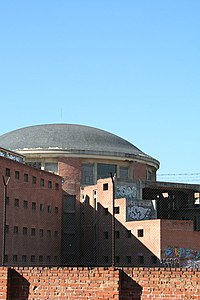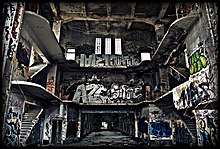Carabanchel Prison
 | |
 | |
| Location | Carabanchel, Madrid, Spain |
|---|---|
| Coordinates | 40°22′53″N 3°45′19″W / 40.3815°N 3.7553°W |
| Population | 2,000 men and 500 women (as of 1999) |
| Closed | 1998 |

Carabanchel Prison (Spanish: Cárcel de Carabanchel) was a prison located in the Carabanchel neighbourhood of Madrid, Spain. It was opened in Francoist Spain in 1944 to house political prisoners after the Spanish Civil War. Carabanchel Prison was one of the biggest prisons in Europe until its closure in 1998 and its demolition in 2008.
History
Carabanchel Prison was constructed between 1940 and 1944 by the Spanish State government of caudillo Francisco Franco using the panopticon model. Many of its inmates were political prisoners arrested after the Spanish Civil War, including members of socialist, anarchist, communist and Marxist political parties and trade union leaders. Notable inmates included Marcelino Camacho (leader of the Comisiones Obreras) and the rest of its top-ranking members as a result of the Process 1001, Julián Ariza (member of the same union), Nicolás Redondo (leader of the Workers' General Union), Eduardo Saborido, Simón Sánchez Montero (Communist Party leader who served 25 years in prison),[1] José María Ruiz Gallardón (monarchist opponent of Franco and father of the former Minister of Justice Alberto Ruiz Gallardón),[2] Nicolás Sartorius,[3] Ramón Tamames,[4] Enrique Múgica and Enrique Curiel (communist activists), Miguel Boyer (Spanish Socialist Workers' Party activist and later minister),[5] Fernando Sánchez-Dragó,[6] Miguel Gila,[7] Fernando Savater,[8] Fernando Arrabal,[9] Agustín Rueda,[10] CNT member Luís Andrés Edo and would-be Franco assassins Stuart Christie and Fernando Carballo Blanco. In the mid-1970s, Carabanchel briefly housed transgender activist Silvia Reyes for being a "transvestite" (the then-current term for a trans woman).[11] Colombian cocaine kingpins Jorge Luis Ochoa Vásquez and Gilberto Rodríguez Orejuela were also imprisoned in Carabanchel in the mid-1980s.[12] After Franco's death in 1975, only common criminals and members of the Basque separatist group ETA and other paramilitary groups remained.
The Coordinadora de Presos en Lucha, that struggled for prisoners rights and amnesty during the first years of the Spanish transition to democracy, was founded in the Carabanchel prison.[13] Several prisoners revolts occurred during that time period.[14]
After its abandonment, the building was heavily looted and inhabited by non-Spaniards. Most of the prison walls were covered with graffiti, some of them very elaborate. A lengthy debate took place between the neighbours of Carabanchel and Aluche, who wanted a hospital and other public facilities to be built in the area,[15] and the local authorities, who wanted to privatize the land for housing development. The neighbours also wanted part of the prison to be preserved.
Finally in July 2008, local and national government reached an agreement on the future of the prison lot, projecting to build 650 apartments, a hospital, green zones and government buildings on the former prison grounds. Despite protests, the entire Carabanchel complex was demolished in late 2008.
Notes
- ^ Una placa conmemorativa en la antigua cárcel de Carabanchel recordará a las víctimas de la represión franquista Archived 2015-11-20 at the Wayback Machine, Europa Press, 21 June 2008.
- ^ Borasteros, Daniel (16 June 2008). "Interior obtendrá cerca de 70 millones con la cárcel de Carabanchel". El País (in Spanish). Retrieved 2008-06-21.
- ^ "Los últimos de Carabanchel, Magazine de El Mundo". Archived from the original on 2015-11-20. Retrieved 2009-12-23.
- ^ El Defensor del Pueblo empieza a defenderlo Archived 2015-11-20 at the Wayback Machine, in Ramón Tamames' blog.
- ^ Los «rojos» vuelven a la cárcel de Carabanchel... de visita, El Mundo, 19 November 1998.
- ^ Tras 50 años de búsqueda, el pasado verano Sánchez Dragó localizó el cadáver de su padre, El Mundo, 22 February 2004.
- ^ La cárcel de Carabanchel pide un hueco en la memoria histórica Archived 2015-11-20 at the Wayback Machine, Soitu, 19 September 2008.
- ^ ¿El final de la cordura?, tribuna de Fernando Savater en El País, 3 November 2008
- ^ "Perfiles: Arrabal - Un eterno rebelde". Archived from the original on 2018-03-06. Retrieved 2009-12-23.
- ^ Prades, Joaquina (27 January 1980). "La extraña muerte de Agustín Rueda". El País.
- ^ Benito, Emilio de (2004-12-19). ""Estuve detenida más de 50 veces"". El País (in Spanish). ISSN 1134-6582. Archived from the original on 2024-06-25. Retrieved 2022-10-05.
- ^ "Spain: The European Base for Latin American Organized Crime". 9 February 2021. Archived from the original on 25 June 2024. Retrieved 12 February 2021.
- ^ "COPEL. La historia de un periodo en la lucha..." 2013-09-18. Archived from the original on 2013-09-18. Retrieved 2024-07-21.
- ^ Redacción (2016-12-09). "Víctimas en el franquismo y olvidados en la democracia". Diario de León (in Spanish). Retrieved 2024-07-21.
- ^ The neighbours' project for the prison lot[usurped]
References
- Chance, C. (2005) Carabanchel: The Last Brit in Europe's Hellhole Prison. Mainstream.
- Díaz Cardiel, V. (2007) "Algunos recuerdos de mis cuatro estancias en la cárcel de Carabanchel" El Rapto de Europa 11: 13–19.
- Photos from the prison [1]
- Photos from Carabanchel at flickr.com [2]
- Urban-travel.org @ The Carabanchel Prison, photos from inside [3]
External links
![]() Media related to Carabanchel Prison at Wikimedia Commons
Media related to Carabanchel Prison at Wikimedia Commons
